How Much My Digital Nomad Lifestyle Costs: Real Budget Numbers from Nearly 7 Years on the Road
[Looking for Europe-specific travel costs? Here’s a similar post with a focus on Europe.]
If you’ve been around awhile, you already know that the number one question I get as a full-time traveler is this:
How do you afford to travel the world full-time?
I do my best to answer this question along the way, sharing my real monthly budgets for stays in places like Rome and Paris and the Italian countryside, writing monthly about my location-independent career as a content strategist and writer, and even interviewing other full-time travelers about their spending.
A couple years ago, in my ongoing efforts to give a full and transparent answer to the question, I wrote a detailed post about expenses. And a few days ago, I realized that that post was due for a major update.
So today I’m doing just that: giving you a detailed look into how I manage my expenses while traveling the world full-time and running my freelance business—everything from day-to-day living expenses to health insurance to those unexpected bits and pieces that sometimes crop up.
Without further ado, then, here’s everything you ever wanted to know about budgeting for full-time travel.

First, a few things you should know…
The first thing you should know is that my lifestyle of full-time travel is something that I do on the same budget (or less) than I lived on in the US. This is the key to making long-term travel a reality. Wherever you are in the world, having a financially sustainable life is about spending less than you make.
The second thing you should know is that there are people who travel the world full-time on less than I budget. In part, this is because I don’t pick places because they’re cheap; I pick them because they’re beautiful or because my friends are there or because I’m just curious. In part it’s because I don’t stay in the cheapest accommodation possible or keep to a very tight food budget and, since I’m working and traveling with a dog, I rarely housesit or couch-surf. So keep in mind that my budgets are not “the” budgets, my way of traveling is not the only way digital nomads and remote workers travel. We’ve all got our own very distinct ways of living.
So, what’s my way of traveling?
I travel with a partner and a dog.
My heart belongs to Europe, so we spend most of our time there.
We typically stay in one base for 1 – 3 months at a time and almost always choose to rent comfortable apartments in local neighborhoods rather than stay in hotels, hostels, B&Bs, or guesthouses (though for short stops in between bases or weekends away, we do hotels, B&Bs, and hostels).
We’re foodies through and through, so we devote a large portion of our budget to good, fresh, usually organic food.
We are working while traveling, which means we spend a good portion of the week holed up at home working on projects.
And in our spare time, we cycle, hike, read, explore, and eat, most of which is cheap or free and keeps entertainment budgets on the low side.
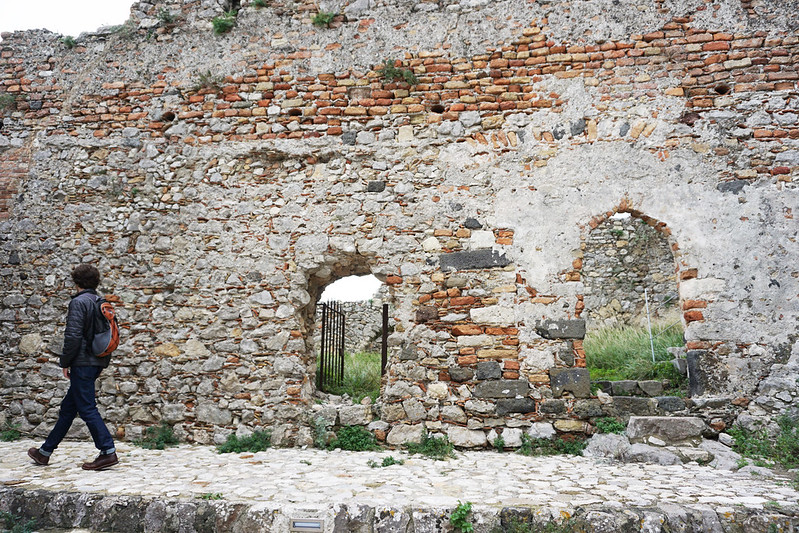
Please note that this post may include affiliate links, which means if you click on a link, I get a commission or credit at no extra cost to you.
My Nomadic Monthly Living Expenses
My biggest expense, both in the states and abroad, is housing. When I was traveling solo, I spent about $1,000 per month. Now that I’m splitting rent, we can afford to stay in nicer spaces and still keep our individual spending lower. I shoot for less than $800 per month and often happily come in under $600.
Keeping housing costs reasonable is one of the reasons we travel so slowly. Because monthly apartment rental prices are significantly lower than nightly or even weekly prices. This is why I prefer Airbnb to the other apartment rental sites out there: owners include the monthly prices as well as the nightly and weekly rates, so you can see the long-term prices with just a couple clicks.
The other major every-month living expense is, of course, food. Eating fresh, high-quality food is very important to me, so I’ve always allowed myself to spend more money on it. In the states, I shopped at Whole Foods and tried to buy healthier options, which were often a bit more. In Europe, I shop at fresh markets, local butchers, and tiny bakeries most of the time and stay away from imports that might have questionable chemicals or ingredients.
I don’t attach a specific number to my food line item, but always strive to only buy what I need and to buy it in the best quality, most local form I can. I mostly cook at home instead of eating out and when I do eat out I go for quality over quantity. Chad and I can usually share a single entree (and perhaps a dessert) and walk away satisfied, so eating out costs tend to run low.
In Croatia, my full food spending (for both eating in and out) landed around $350. In Playa del Carmen, Mexico, it was a little over $400. And in Paris, it came in just under $450. So, while it varies, it generally stays within the same range and is very similar to what I used to spend in Colorado.

The third major monthly expense is transportation. For me, this usually means one or two train and bus tickets. During the month, I choose to walk whenever possible (which, in Europe, is nearly always) and only take buses and metros when the weather is walking-prohibitive or if the walk would be more than an hour long. This keeps my transport costs way lower than they were in the US, since my US costs included car insurance, car payments, gas, car maintenance, and yearly tag renewals (conservatively, I was spending at least $500 per month). These days, I spend anywhere from about $30 (an overnight train ticket from Italy to Paris on sale) to $350ish (trains from Paris to Split, Croatia).
Finally, my monthly expenses include Luna’s food and care, which varies a little from country to country, but rarely exceeds $100 per month, and entertainment/fun money, which actually often ends up being less than I spent in the states because abroad I’m more content to simply take long walks, hike, and participate in all manner of other free or cheap activities.
Supplies tend to run less abroad as well, in part because I am careful about what I buy, since I carry everything on my back, and, in part, because I’m less bored and thus feel less of a need to shop. The ironic and wonderful thing about this is that the things I buy are often higher quality and more expensive, yet I generally spend less overall than I did in the states.
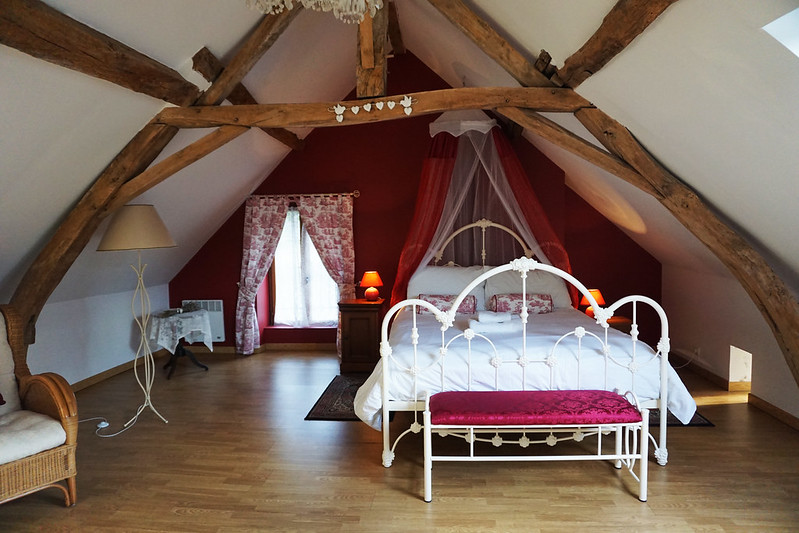
Finally, there’s health insurance and healthcare. I pay $160 per month for GeoBlue insurance that covers me anywhere in the world except the US. So far, they’ve been a dream. They set up direct billing for my annual exam in Rome so that I didn’t have to fill out any claim forms and have been quick to respond to email inquiries.
Previously, I tried travel insurance through World Nomads, which I found wildly frustrating (despite marketing themselves to travelers, they require you to jump through a LOT of paperwork hoops that require access to printers, scanners, and copy machines) and IMG Global, who ignored my emails and took months upon months to even acknowledge my claims after I was hospitalized on Malta. I would not recommend either company.
Which brings me to the other ongoing, variable expense: healthcare. Doctor visits. Dentist visits. Medications. The good news is that the rest of the world tends to run way cheaper than the US. Three months of birth control in the US cost me about $150 out of pocket (and that’s with a discount) pre-Obamacare. A doctor’s visit and a three-month supply of birth control in Germany, by contrast, cost me under $100. And three months of birth control in Switzerland? Less than $50.
In all, I try to keep monthly spending under $2,000. (And even with this as my budget ceiling, I very often come in far under. Some simple math on the three most recent monthly budgets shows an average falling around $1,600.)
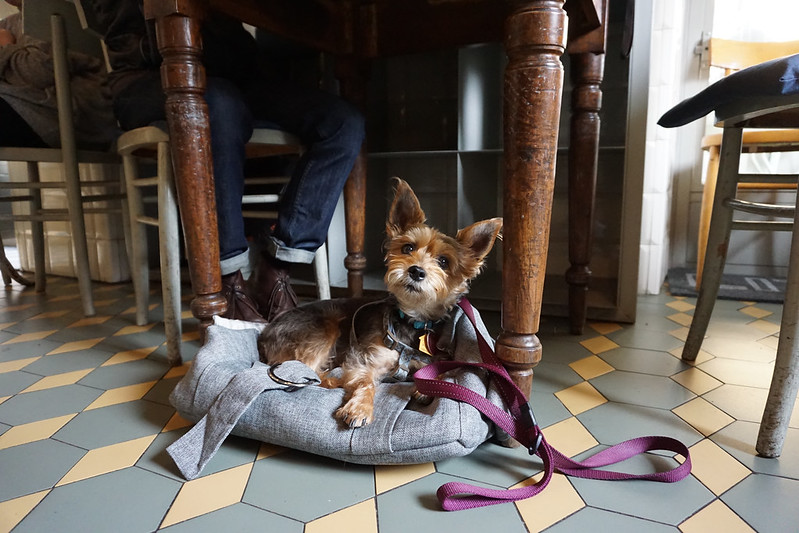
For those who’d like a more detailed look at my monthly budgets around the world, here they all are categorized by price range (click on the pink links for details on the budgets):
Under $1,500 per month:
Konjic, Bosnia and Herzegovina / one month ($1157)
Tulum, Mexico / one month ($1232)
Mostar, Bosnia and Herzegovina / one month ($1296)
Sayulita, Mexico / one month ($1301)
Split, Croatia / one month ($1317)
Zagreb, Croatia / one month ($1337)
Playa del Carmen, Mexico / one month ($1350)
Taormina, Italy / one month ($1364)
Kranjska Gora, Slovenia / one month ($1385)
Toledo, Spain / one month ($1388)
Kobarid, Slovenia / one month ($1422)
Brasov, Romania / one month ($1433)
Dubrovnik, Croatia / one month ($1443)
Under $1,800 per month
Interlaken, Switzerland / one month ($1558)
Ljubljana, Slovenia / two weeks ($808)
Rennes, France / one month ($1648)
Nerja, Spain / one month ($1689)
Edinburgh, Scotland / one month ($1697)
Ljubljana, Slovenia / second stay, one month ($1735)
Grenoble, France / one month ($1739)
Prague, Czechia / one month ($1752)
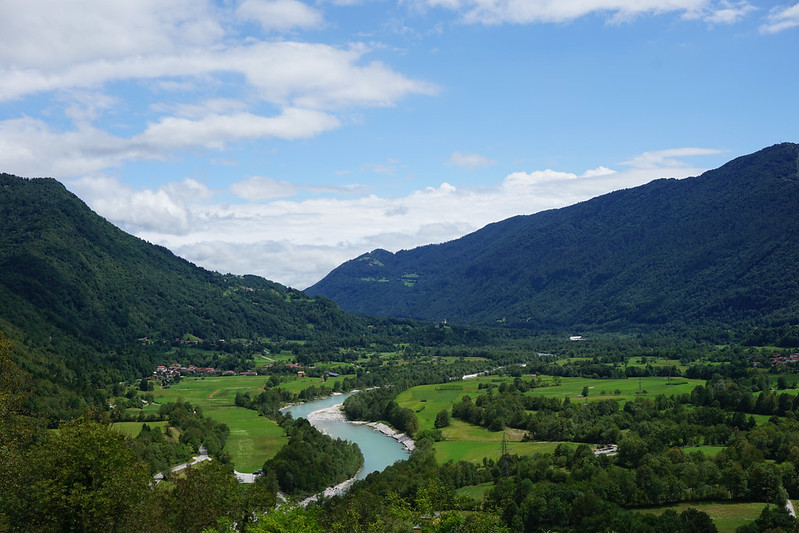
Under $2,000 per month
Perugia, Italy / one month ($1882)
Flagstaff, Arizona / one month ($1893)
Rome, Italy / one month ($1911)
Chamonix, France / two weeks ($962)
Vancouver, Canada / one month ($1988)
Over $2,000 per month
Lauterbrunnen, Switzerland / three monthly budgets compared (varies)
Amsterdam, Netherlands / two weeks ($1008)
Biarritz, France / one month ($2029)
Innsbruck, Austria / one week ($511)
Paris, France / one month ($2118)
New York, New York, USA / one month ($2297)
Cycling across France / one month ($3091)

Business Costs
I generally separate my business expenses from my regular monthly expenses, since they vary pretty wildly.
Monthly, I pay $6 for my Skype phone number, which allows me to take unlimited incoming calls from the US. The Skype number is a US phone number, which means people in the US can call at US prices no matter where in the world I am, as long as I have an internet connection. This is how I stayed connected and accessible to my US clients while traveling.
I also pay $10 at a time for credit on a Google Voice account, which allows me to make outgoing calls cheaply. I use it to call people in the states and all over Europe and the cost tends to range from one to three cents per minute. This isn’t a set monthly expense and if I had to guess I’d say that I probably spend $10 per year right now.
Once a year or once every few years, I also have expenses for web hosting and domain renewal for the website. This costs me less than $100 per year.
Another variable cost is contract labor. Sometimes I hire a developer or a designer (like the fabulous illustrator who did this). These are one-time expenses and vary greatly, so I budget for them as needed on a per-project basis. I also tend to rely a lot on trades, offering up writing or strategy consulting in exchange for design or development work that I can’t tackle myself.
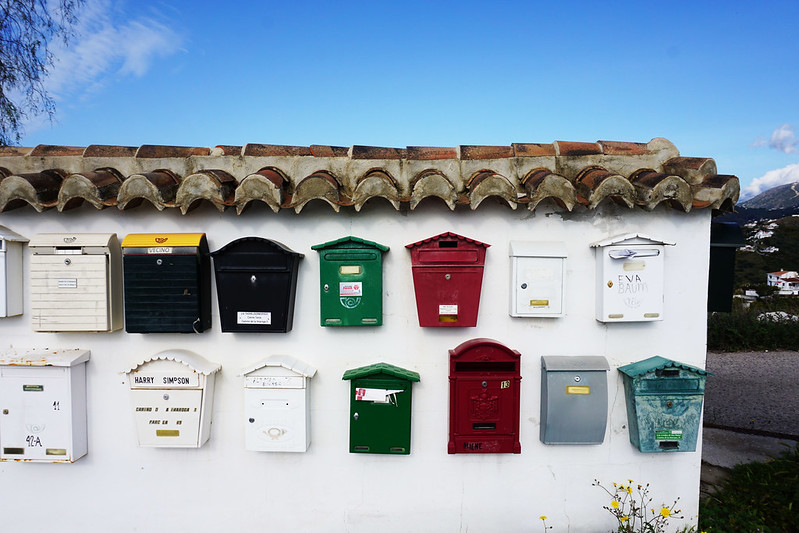
Finally, there are taxes. In general (though not in every case), you are expected to pay taxes in the place you reside. When I was a US resident, I paid in the US. When I was a legal resident of Switzerland, I still had to file taxes in the US, but I was eligible for the FEIE in the states and paid taxes in Switzerland.
For those paying in the states and self-employed, taxes are due quarterly, not yearly. So every three months I’d calculate the taxes I owe (to the best of my not-a-math-whiz ability) and send the government a check. Then at the end of the year I would do a much more detailed calculation (usually with the help of a tax professional, which adds another $300 – $350 in expense to my yearly tally) to make sure everything had been paid properly.
Quarterly & Annual Expenses
There are a few things I don’t budget for monthly (or include in my monthly budget posts) because they are yearly or quarterly expenses and may vary greatly from month to month. One of these things is plane tickets.
I’m not a traveler that flies a lot, preferring to explore one continent thoroughly at a time and take trains where possible both because it’s simply a more pleasant way to travel and because the older I get the worse my plane-sickness gets, so flying has stopped being even a little bit fun.
So, since I’m not buying them monthly or even bi-monthly, I usually don’t track plane ticket costs monthly and instead factor them into my budget on a quarterly or yearly basis. This year, we’ve taken one flight so far (50 minutes from Zagreb to Dubrovnik, Croatia) and plan on taking one to two more, both within Europe, so they shouldn’t represent a huge expense.
Replacing technology (my laptop or tablet), big one-time medical expenses, and other large one-time purchases (like my recent purchase of a folding bike) are also something I look at quarterly or annually rather than monthly.
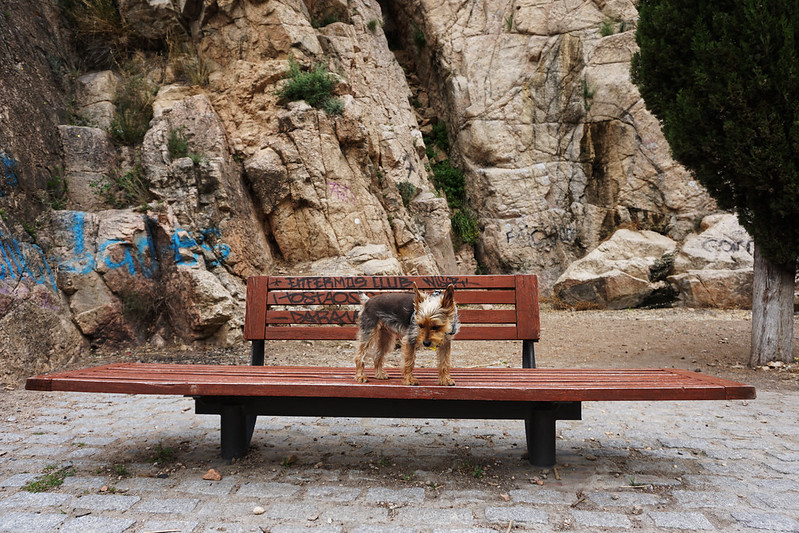
Expecting the Unexpected & Planning for the Future (Savings)
Finally, for me, part of feeling comfortable starting my business and then, a year or so later, leaving to travel full-time was having a decent financial buffer in the bank. I was advised while starting my business to have at least six months worth of expenses in the bank just in case. Being a bit neurotic about money, I waited until I had 10 months and enough clients that I was already almost breaking even.
Similarly, when I started traveling, even though I would be working normally and hopefully earning normally, part of feeling comfortable was the knowledge that I had a buffer. If all my clients ditched me in month one, I could live for a year without income (assuming I lived relatively frugally).
Everyone operates differently on this. When my aunt started her business, she quickly went into debt. Yet she was wildly successful over time. I’ve also heard stories of those who moved to a cheap part of Asia to start their business, which meant the limited funds they had could last them much longer while they got things off the ground. I know one man who told me it’s going to take $150,000 to start his business. Another woman told me a success story that started with just 3,000 euros in the bank. An old roommate told me she’s been traveling and working for years with just a few hundred euros to her name.
My income is variable, but I also try to set aside a decent percentage each month for the future–both to tackle unexpected expenses or emergencies and, of course, to create more security for myself in case I ever cannot or no longer want to work. I’m pretty risk-averse and frugal, so I’ve always found ways to squirrel money away, even when I was in school, was working as a waitress in Pennsylvania after college, and was living in pricey NYC.
Any expenses you tend to have during travel that I haven’t mentioned? Any questions about travel expenses and budgeting? Toss them in the comments.
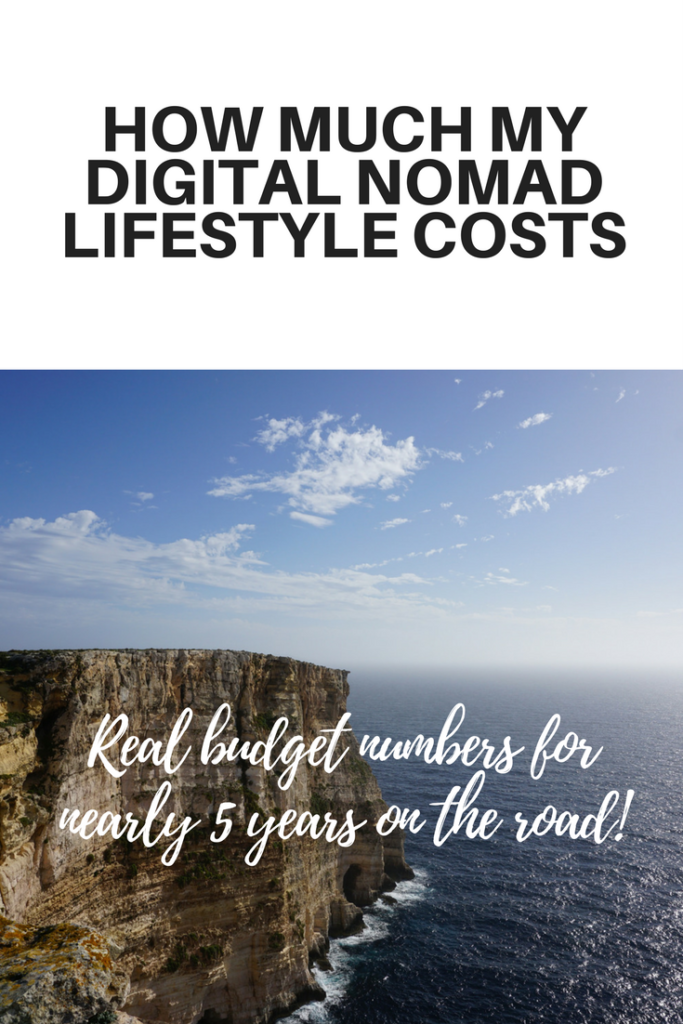
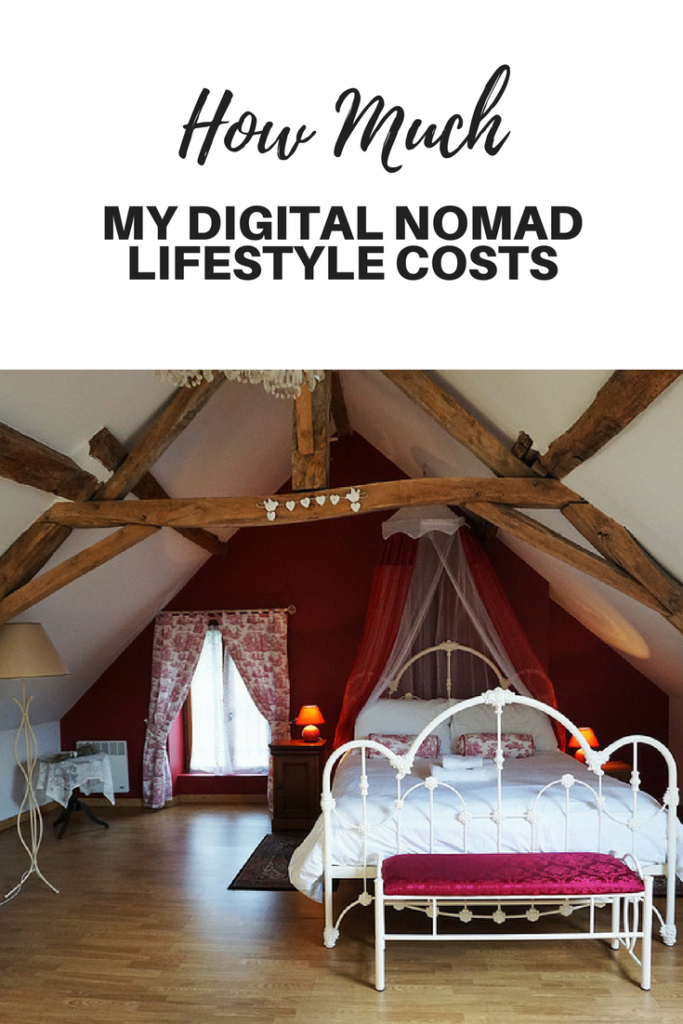
Comments
-
-
Gigi
I’m sure it’ll depend where we are. So far we’ve mostly been in places where good food is cheap (Rome) or places where we don’t eat out as often (here in Dubrovnik, for example). But I’ve also spent like $300 on a single dinner before, so not always a budget angel in the food department for sure.
And yes – that room was soooo pretty! It’s a little French countryside gite. If you guys ever need a getaway space in the Loire Valley, let me know and I’d be happy to connect you with the owners.
-
-
Jen
Fun fact: birth control for 3 months in SE Asia is less than $10 🙂
-
David Feldsott
Great budget breakdown! Really well done.
Random question: Where did you find your tax professional? It’s tax season and my nomadic lifestyle has made it difficult to find a knowledgable tax professional that doesn’t want to charge me $1,500+ for filing my business returns. Thanks!
-
Maria
I just talked to my husband about this yesterday and he told me it is not possible. Ha, I just emailed him your article 😉
Thank you!
-
Carolyn Smurthwaite
Awesome post! Thanks for sharing 🙂 I’ve been wanting to do the digital nomad lifestyle myself and have been playing around with budgets. Being in Mexico, food budgets are a must as eating out here can be questionable.
How long were you working in the states for before you began traveling full time?
-
Melly
Where did you start your travels?
-
Balint
Loved how detailed you mentioned your costs and the fact that you buy at markets. Walking in Europe is the best. Do you work from the apartments you rent?
-
Paul Holland
Great post thanks for sharing, one point I notice (I’m guessing your American) is how much you guys value health care and are prepared to put a relatively high price on it. We pay nothing a month in comparison and just pay as we go, dental and doctor visits in underdeveloped parts of the world are next to nothing, I guess its a cultural thing? (we’re British/Australians-in our 40s) we just aren’t use to paying for healthcare and don’t mind paying for it as we need it, it really doesn’t seem that expensive outside the US and worse comes to the worse we could go home to mum!
-
Rose
Thanks for sharing! Doing the digital nomad thing 2 months from now and this information is very helpful!
-
Chris
Hi Can you clarify the numbers please, of your monthly spending- (Taormina 1364 and up from there). Do these amounts all refer to your half of the expenses while travelling with a partner, or in other words, did your partner spend +/- the same amount/month? This would mean a minimum budget of 2700+ for two…..or a budget well above 4000 in France…
-
El Tee
Really great article. I aspire towards a lifestyle like this. Hopefully in no more than 5 years. It’s great to know that it’s relatively easy to stay within a “normal” budget although my plans are currently based on spending around a grand a month (sans savings).
-
Alex
Hey, great article!!!
Are those numbers that you broke down to monthly expenses go to by one person or for your whole family (2 people + dog) ? Thank you 🙂 -
Helen Graham
Hi
Thank you your blog is inspiring. My husband and I are going to do something similar even though we are over 60. We are starting next month in Portugal.
One question – what did you do for a bank account or did you just use a US bank card for day to day cash? -
Mike
My wife and I have traveled about 4 months a year in SEA for the past three years and are planning to do 2 months or so in Europe next year. The costs do not look terribly different to us in much of Europe. Eating dinner out looks to be more expensive in Europe, but also seems to use more expensive ingredients (much more meat and cheese in particular) so that’s somewhat forgivable. Living in one SEA city long term might be cheaper, but a month at a time in each country I’m not so sure, especially if you like western food now and then and you’re getting too old to enjoy hostels.
Most of the year we live in China, have an apartment paid for by my employer, and could live off next to nothing if we wanted to (we rarely spend more than $500 per month), but I think spending less than $50 per day or so as a couple traveling in SEA would not be much fun. Might seem cool for a couple weeks but not months or years, especially as a couple. Renting a small apartment where you can get some work done would bump that up by $30/day easy for short-term rentals, which would put things fairly close to some of your recent budgets for similar in Europe.

Ali
You’re so much better at your food budget than Andy and I are! We eat out a few times a week, or just get lazy and order delivery. But like you said, your expenses for living a nomadic life are really comparable to having a permanent home. Because you’re not shelling out $100 a night in hotels and splurging on tourist attractions every day. I think people miss that sometimes, that traveling full time is not the same as vacation.
Also, that room with the wood beamed ceiling is gorgeous!